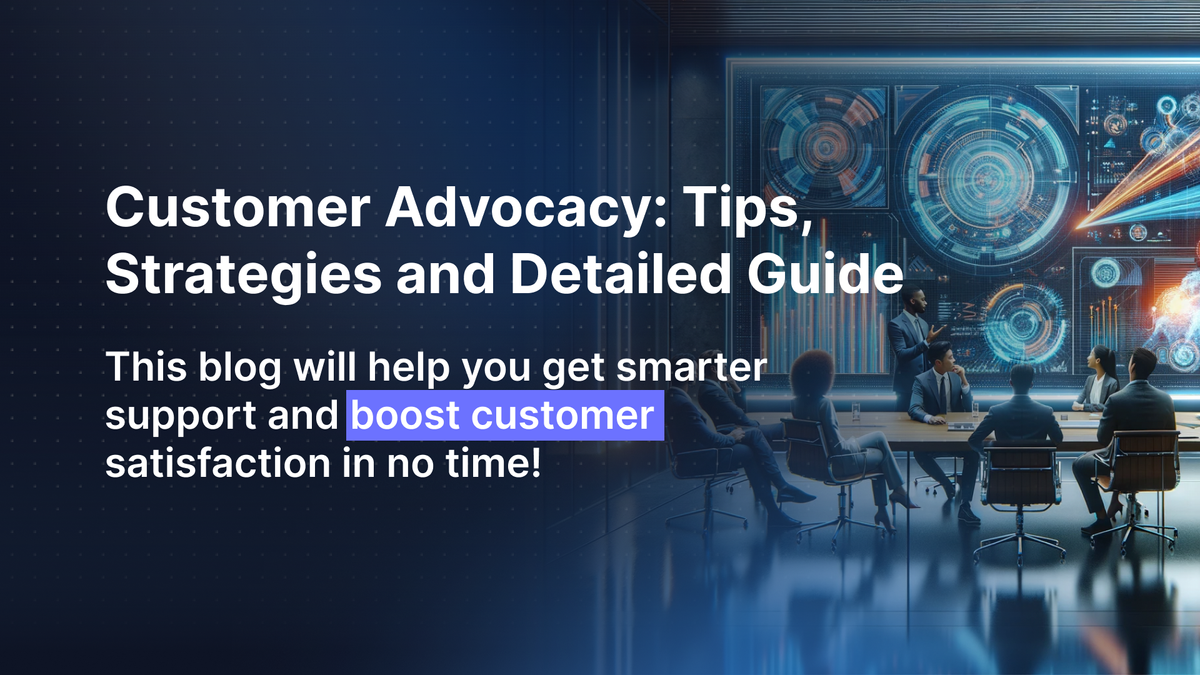Transform business interactions with practical strategies of customer advocac...

Customer advocacy is a powerful tool in the modern business landscape. It revolves around turning customers into loyal advocates for your brand who continue to buy your products and promote them to others. This blog will explore what customer advocacy entails, its importance, and practical ways to harness its power within your organization.
Customer advocacy is a customer-centric model that prioritizes the customer's interests above all other considerations within a business. This approach focuses on satisfying customers and ensuring their experiences are so positive that they become active proponents of your brand.
After assessing the customer advocacy definition, now’s the time to explore its main features. At its core, customer advocacy involves:
While customer service is about meeting the customers' needs, customer advocacy takes a step further by empowering them and actively involving them in the growth process of the brand. It's a strategy that turns passive customers into active participants willing to share their positive experiences with others.
In today's hyper-competitive market, customer advocacy has become a crucial differentiator for businesses. It extends beyond mere customer satisfaction, encouraging loyalty and creating brand ambassadors. According to a Nielsen study, 92% of consumers trust recommendations from people they know, making customer advocacy a powerful tool in brand promotion.
Increased Retention: Advocacy helps in retaining customers. Satisfied customers are more likely to stay with a brand that values their input and addresses their needs.
Word-of-Mouth Marketing: Advocates are likely to share their positive experiences with others, leading to new customer acquisitions without the direct cost of traditional marketing efforts.
Companies like Apple and Amazon have leveraged customer advocacy effectively, focusing on creating exceptional customer experiences that encourage customers to become vocal supporters of their products and services.
Investing in customer advocacy is not just about improving customer service; it's about creating a holistic experience that resonates with customers on a personal level. Businesses that invest in understanding and implementing advocacy report higher customer satisfaction rates, increased sales, and better customer retention.
Enhanced Customer Loyalty: Customers who feel valued are likelier to be loyal.
Increased Revenue: Loyal customers buy more and increase sales through referrals.
Competitive Advantage: A strong advocacy program sets a company apart from competitors who may not prioritize customer interests to the same extent.
A consumer advocate acts as a champion for customer rights and satisfaction within a company. This role goes beyond traditional customer service by proactively seeking to understand, protect, and advance customer interests. Consumer advocates listen to customer concerns, ensure their issues are addressed, and help influence company policies in favor of consumer well-being.
Consumer advocates wear several hats, depending on the situation and the customers' needs. Here's what they typically do:
When customers know that a company has their back, it fundamentally changes their perception of the brand. They feel valued and understood, which builds deep emotional connections. These connections are powerful drivers for both loyalty and advocacy. A study by Deloitte highlighted that 88% of companies consider customer experience their biggest competitive lever.
Exploring real-life examples provides a clearer understanding of how customer advocacy can significantly transform a business. Here, we dive into several case studies where brands successfully implemented customer advocacy programs, leading to increased satisfaction and business growth.
Starbucks' "My Starbucks Idea" platform showcases a classic example of customer advocacy. Launched in 2008, this initiative allowed customers to submit suggestions directly to the company, ranging from new product ideas to improvements in customer service.
Customers posted ideas, others voted, and Starbucks implemented over 300 suggestions, including the popular splash sticks and free Wi-Fi in stores.

This move not only improved customer loyalty but also drove innovation within Starbucks. The platform fostered a community around the brand, making customers feel valued and heard.
Adobe's Product Improvement Program demonstrates how incorporating customer feedback into product development can boost user satisfaction and advocacy.
Adobe collects anonymized data on how users interact with their software, which helps them identify pain points and areas for enhancement.
This ongoing feedback loop has helped Adobe refine its products, ensuring they meet the evolving needs of users and maintain high satisfaction rates. This strategy has helped Adobe sustain its position as a leader in creative software.
Tesla's approach to customer advocacy revolves around its direct user feedback loop. CEO Elon Musk often engages with customers on App X, responding to complaints and suggestions.
When a Tesla owner tweeted about an issue at a Supercharger station, Musk responded directly, and the problem was resolved quickly. This direct interaction and responsiveness enhance customer trust and loyalty.
This strategy resolves individual issues and enhances public perception of Tesla as a responsive and customer-focused brand.
Slack, the communication platform, integrates customer feedback into its product development cycle, making it an exemplary B2B customer advocacy case.
Slack has mechanisms to gather extensive user feedback that directly influences feature updates and product roadmaps.
This approach has resulted in highly tailored solutions that meet the specific needs of businesses, leading to high retention rates and strong customer advocacy.
Creating advocate customers involves more than exceptional customer service; it requires a strategic approach backed by data to understand and foster deeper customer engagement. Here's how businesses can effectively transform satisfied customers into active promoters.
According to a study by Microsoft, 77% of consumers view brands more favorably if they proactively invite and accept customer feedback. Customer satisfaction surveys and Net Promoter Scores (NPS) can provide actionable insights that help tailor customer experiences toward more excellent advocacy.
A report by Epsilon indicated that 80% of consumers are more likely to purchase when brands offer personalized experiences. This personal touch can significantly boost customer satisfaction, turning regular customers into staunch advocates by showing them that their preferences and behaviors are recognized and valued.
Social proof remains a powerful tool in converting customers into advocates. 92% of people trust recommendations from peers over advertising when making a purchase decision. Highlighting customer testimonials and success stories on your platforms can inspire confidence in prospective and current customers, encouraging them to share their positive experiences.
Implementing customer engagement programs like referral incentives can significantly amplify advocacy. A study by Texas Tech University found that 83% of satisfied customers are willing to refer to products and services, yet only 29% are satisfied. Companies can tap into this potential by creating structured referral programs, turning satisfaction into active promotion.
Service advocacy is a dynamic approach within customer service that emphasizes proactive support and customer involvement to resolve issues and elevate the overall customer experience. This strategy is becoming crucial in an era of continually evolving customer expectations.
Service advocacy refers to the actions and policies to defend customer interests in service delivery. It involves understanding customer needs deeply, advocating for those needs within the organization, and ensuring that every interaction adds value to the customer relationship.
A study by American Express found that 33% of Americans would consider switching companies after a single instance of poor service. This statistic underscores the critical nature of high-quality customer service in maintaining consumer loyalty.
Enhancing the customer service experience through advocacy involves several strategic steps:
Proactive engagement means anticipating customer needs and addressing them before they become issues. According to a report by InContact, 87% of adults surveyed are happy to be contacted proactively by companies regarding customer service issues.
Integrating a continuous feedback loop into service processes helps refine and improve service delivery. Zendesk reports that 62% of B2B and 52% of B2C customers purchase more after a good customer service experience.
Training programs should focus on standard service protocols and teaching reps how to be customer advocates — understanding customer pain points, empathizing with their situation, and working towards a resolution that benefits the customer beyond the immediate concern.
Leveraging technology like CRM systems can provide representatives with comprehensive customer histories, enabling personalized service that anticipates and meets specific customer needs. Utilizing AI and machine learning can also help predict customer issues before they escalate.
Creating a culture that prioritizes customer advocacy involves:
Integrating artificial intelligence (AI) into customer service revolutionizes how businesses manage customer interactions and enhance service advocacy. AI technologies, such as chatbots and AI-driven analytics, are turning customers into advocates by offering personalized, responsive service.
AI's impact on customer service is profound, with significant speed, efficiency, and personalization advantages. A Salesforce report shows that 51% of customer service organizations use AI.
AI chatbots can interact with customers around the clock, immediately responding to common inquiries. This continuous availability enhances customer satisfaction, as supported by a report that stated that 58% of B2B businesses have started using chatbots.
In 2017, 20% of companies used AI for at least one business function. By 2022, this ratio crossed 40%.

That's because AI systems can handle thousands of interactions simultaneously, something impossible for human agents. This capability significantly reduces wait times and improves efficiency, which is crucial for scaling customer service operations without compromising quality.
AI tools analyze vast data to provide personalized service recommendations and solutions. This tailored approach increases customer satisfaction and builds loyalty and advocacy by making customers feel valued and understood.
AI's predictive analytics can forecast potential issues before they arise, allowing companies to address them proactively. For instance, an AI system might analyze usage patterns to identify and resolve service disruptions before they affect a significant number of customers.
AI doesn't just replace human agents; it augments their capabilities. By handling routine inquiries, AI allows human agents to focus on complex issues that require a personal touch, thus enhancing the overall quality of service.
Companies like Amtrak have implemented AI chatbots that guide customers through booking tickets, answering queries, and providing travel updates. Amtrak's chatbot, Ask Julie, has reportedly increased bookings and customer satisfaction significantly since its launch.
Telecom companies use AI to monitor network traffic and anticipate service issues, sending alerts and deploying fixes often before customers experience any disruption. This proactive approach prevents dissatisfaction and reinforces the company's reputation for reliability.
The world of AI support and AI customer service puts your business at the forefront of innovation. With tools like AI chatbot customer service, you're enhancing the whole customer experience. This approach isn't just efficient; it's transformative and ensures every interaction feels personal and responsive.
The possibilities for enriching customer service are endless. However, if you want everything to stay seamless and hassle-free, the AI chatbot customer experience is your best bet! So, start incorporating AI for efficient customer service before it is too late!